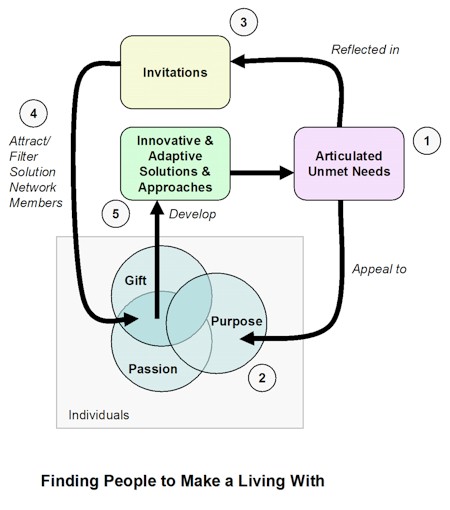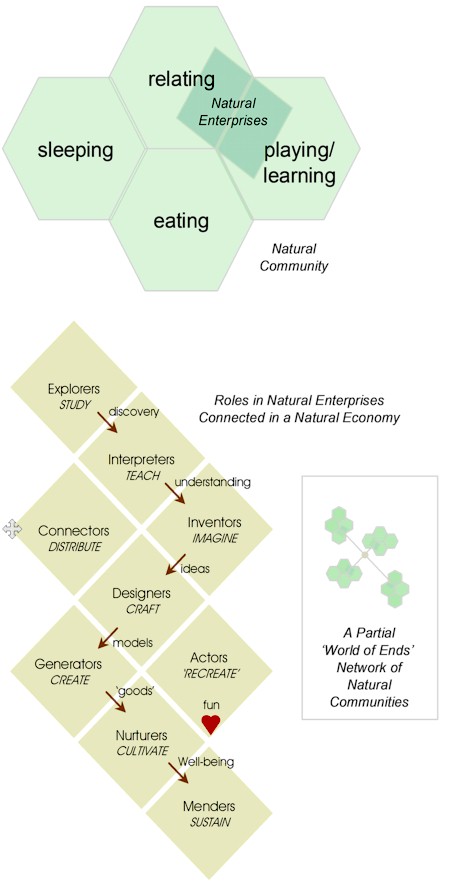
My book Finding the Sweet Spot (see right sidebar for details) suggests a variety of approaches to finding people to partner with in Natural Enterprises. One of these is illustrated above. The idea is to approach a problem with an open mind and as much data as possible, and engage others to help solve it. Here’s a brief walkthrough:
The book explains this in a lot more detail, but you get the idea. Need, Shared Purpose, Invitation, Convocation, Conversation, Collaboration, Innovation. It’s a natural method of collective problem-solving, and it has the advantage of helping you find the people you were meant to work with. Recently I wondered: Could such an approach also be used to find the people you were meant to live with — in Natural (Intentional) Community? As I reflect on the recent fracturing of our massively centralized financial system, and the fragility of our massively centralized political, social, health, business, education and other systems, I grow more and more convinced that Natural Communities and Natural Enterprises, if they are to be resilient enough to survive the threats facing us today, will have to be small-scale, bottom-up, networked and as self-sufficient as possible (the last two qualities are by no means contradictory). I’ve referred as well to some surveys that suggest that, while Dunbar’s number (150) is the maximum number we can maintain meaningful social relationships with, the optimal size of networks is either 5-7 or 40-60 (the two sizes being optimal for different purposes). Putting all this together it seems it would be appropriate to try to evolve Natural Communities of 40-60 people made up of Natural Enterprises of 5-7 people. If 5-7 people working together seems a small number, consider that their main customer base is only 40-60 people. Also, there are some very powerful enterprises that have only this small number of partners — they network with other small enterprises with different Purposes to meet larger needs, collaboratively, and the Internet and other conversational, organizational and virtual presence technologies make this increasingly easy to do. Some of the oldest advice for finding the person you were meant to live with is to get out and enroll in some activity where you can meet others who share your Passions. And the method above suggests one way of finding the people you were meant to work with is to get out and enroll others in some activity around a shared Purpose. So which would work best for finding people to live with in a Natural Community? I’m thinking about the amazing group I spent three days with this week on Bowen Island BC. We were, in a way, an instant Natural Community. We shared a Passion for facilitation and a Purpose of enabling better conversations and hence making the world a better place by empowering people, bottom up, in their communities. We talked a lot about the objectivity of the facilitator, and when it was best for the facilitator to be a ‘content provider’, bringing a point of view, new knowledge, ideas, even provocations to the group, and when it was better for the facilitator to be a process manager only. And even when it was appropriate for the facilitator to largely do neither, and let the group find its own natural process. My sense is that what made that group so magic was the fact that, as professional facilitators, they are very astute about the process of opening space, drawing people out, letting solutions emerge etc. and hence are extremely competent self-managers and very effective collaborators in just about any imaginable situation. And they all know themselves very well, which is enormously helpful in optimizing productivity and keeping conflicts and negative emotions in check.
So perhaps the ‘rules’ for people who are meant to live together (in Natural Community) and to make a living together (in Natural Enterprise) are these:
This is a tough recipe, and because of the love factor, it isn’t one that can be orchestrated. It needs to be a self-managed process. In pre-civilization times it would have been much easier — there were far fewer people to choose from, and the self-knowledge and twelve core capacities were present in almost everyone (as a Darwinian necessity). And there was no education system to pound these capacities out of us. Nevertheless, it just makes sense to me that this is the natural way to live. It’s effective, resilient, sustainable, responsible, and joyful. It draws on the best of all of us. It taps into our inherent social nature. To find the people for our Natural Enterprise and Natural Community we need first to know ourselves, and to cultivate as many of the twelve core capacities as possible. Then we need to put ourselves out there, authentically and honestly and fully, by offering and accepting invitations that will connect us with others who share our Purpose and our Passions, and help us find those we were meant to live and make a living with. Perhaps it’s not so difficult after all. It might only take a lifetime. Category: Intentional Community
|
Navigation
Collapsniks
Albert Bates (US)
Andrew Nikiforuk (CA)
Brutus (US)
Carolyn Baker (US)*
Catherine Ingram (US)
Chris Hedges (US)
Dahr Jamail (US)
Dean Spillane-Walker (US)*
Derrick Jensen (US)
Dougald & Paul (IE/SE)*
Erik Michaels (US)
Gail Tverberg (US)
Guy McPherson (US)
Honest Sorcerer
Janaia & Robin (US)*
Jem Bendell (UK)
Mari Werner
Michael Dowd (US)*
Nate Hagens (US)
Paul Heft (US)*
Post Carbon Inst. (US)
Resilience (US)
Richard Heinberg (US)
Robert Jensen (US)
Roy Scranton (US)
Sam Mitchell (US)
Tim Morgan (UK)
Tim Watkins (UK)
Umair Haque (UK)
William Rees (CA)
XrayMike (AU)
Radical Non-Duality
Tony Parsons
Jim Newman
Tim Cliss
Andreas Müller
Kenneth Madden
Emerson Lim
Nancy Neithercut
Rosemarijn Roes
Frank McCaughey
Clare Cherikoff
Ere Parek, Izzy Cloke, Zabi AmaniEssential Reading
Archive by Category
My Bio, Contact Info, Signature Posts
About the Author (2023)
My Circles
E-mail me
--- My Best 200 Posts, 2003-22 by category, from newest to oldest ---
Collapse Watch:
Hope — On the Balance of Probabilities
The Caste War for the Dregs
Recuperation, Accommodation, Resilience
How Do We Teach the Critical Skills
Collapse Not Apocalypse
Effective Activism
'Making Sense of the World' Reading List
Notes From the Rising Dark
What is Exponential Decay
Collapse: Slowly Then Suddenly
Slouching Towards Bethlehem
Making Sense of Who We Are
What Would Net-Zero Emissions Look Like?
Post Collapse with Michael Dowd (video)
Why Economic Collapse Will Precede Climate Collapse
Being Adaptable: A Reminder List
A Culture of Fear
What Will It Take?
A Future Without Us
Dean Walker Interview (video)
The Mushroom at the End of the World
What Would It Take To Live Sustainably?
The New Political Map (Poster)
Beyond Belief
Complexity and Collapse
Requiem for a Species
Civilization Disease
What a Desolated Earth Looks Like
If We Had a Better Story...
Giving Up on Environmentalism
The Hard Part is Finding People Who Care
Going Vegan
The Dark & Gathering Sameness of the World
The End of Philosophy
A Short History of Progress
The Boiling Frog
Our Culture / Ourselves:
A CoVid-19 Recap
What It Means to be Human
A Culture Built on Wrong Models
Understanding Conservatives
Our Unique Capacity for Hatred
Not Meant to Govern Each Other
The Humanist Trap
Credulous
Amazing What People Get Used To
My Reluctant Misanthropy
The Dawn of Everything
Species Shame
Why Misinformation Doesn't Work
The Lab-Leak Hypothesis
The Right to Die
CoVid-19: Go for Zero
Pollard's Laws
On Caste
The Process of Self-Organization
The Tragic Spread of Misinformation
A Better Way to Work
The Needs of the Moment
Ask Yourself This
What to Believe Now?
Rogue Primate
Conversation & Silence
The Language of Our Eyes
True Story
May I Ask a Question?
Cultural Acedia: When We Can No Longer Care
Useless Advice
Several Short Sentences About Learning
Why I Don't Want to Hear Your Story
A Harvest of Myths
The Qualities of a Great Story
The Trouble With Stories
A Model of Identity & Community
Not Ready to Do What's Needed
A Culture of Dependence
So What's Next
Ten Things to Do When You're Feeling Hopeless
No Use to the World Broken
Living in Another World
Does Language Restrict What We Can Think?
The Value of Conversation Manifesto Nobody Knows Anything
If I Only Had 37 Days
The Only Life We Know
A Long Way Down
No Noble Savages
Figments of Reality
Too Far Ahead
Learning From Nature
The Rogue Animal
How the World Really Works:
Making Sense of Scents
An Age of Wonder
The Truth About Ukraine
Navigating Complexity
The Supply Chain Problem
The Promise of Dialogue
Too Dumb to Take Care of Ourselves
Extinction Capitalism
Homeless
Republicans Slide Into Fascism
All the Things I Was Wrong About
Several Short Sentences About Sharks
How Change Happens
What's the Best Possible Outcome?
The Perpetual Growth Machine
We Make Zero
How Long We've Been Around (graphic)
If You Wanted to Sabotage the Elections
Collective Intelligence & Complexity
Ten Things I Wish I'd Learned Earlier
The Problem With Systems
Against Hope (Video)
The Admission of Necessary Ignorance
Several Short Sentences About Jellyfish
Loren Eiseley, in Verse
A Synopsis of 'Finding the Sweet Spot'
Learning from Indigenous Cultures
The Gift Economy
The Job of the Media
The Wal-Mart Dilemma
The Illusion of the Separate Self, and Free Will:
No Free Will, No Freedom
The Other Side of 'No Me'
This Body Takes Me For a Walk
The Only One Who Really Knew Me
No Free Will — Fightin' Words
The Paradox of the Self
A Radical Non-Duality FAQ
What We Think We Know
Bark Bark Bark Bark Bark Bark Bark
Healing From Ourselves
The Entanglement Hypothesis
Nothing Needs to Happen
Nothing to Say About This
What I Wanted to Believe
A Continuous Reassemblage of Meaning
No Choice But to Misbehave
What's Apparently Happening
A Different Kind of Animal
Happy Now?
This Creature
Did Early Humans Have Selves?
Nothing On Offer Here
Even Simpler and More Hopeless Than That
Glimpses
How Our Bodies Sense the World
Fragments
What Happens in Vagus
We Have No Choice
Never Comfortable in the Skin of Self
Letting Go of the Story of Me
All There Is, Is This
A Theory of No Mind
Creative Works:
Mindful Wanderings (Reflections) (Archive)
A Prayer to No One
Frogs' Hollow (Short Story)
We Do What We Do (Poem)
Negative Assertions (Poem)
Reminder (Short Story)
A Canadian Sorry (Satire)
Under No Illusions (Short Story)
The Ever-Stranger (Poem)
The Fortune Teller (Short Story)
Non-Duality Dude (Play)
Your Self: An Owner's Manual (Satire)
All the Things I Thought I Knew (Short Story)
On the Shoulders of Giants (Short Story)
Improv (Poem)
Calling the Cage Freedom (Short Story)
Rune (Poem)
Only This (Poem)
The Other Extinction (Short Story)
Invisible (Poem)
Disruption (Short Story)
A Thought-Less Experiment (Poem)
Speaking Grosbeak (Short Story)
The Only Way There (Short Story)
The Wild Man (Short Story)
Flywheel (Short Story)
The Opposite of Presence (Satire)
How to Make Love Last (Poem)
The Horses' Bodies (Poem)
Enough (Lament)
Distracted (Short Story)
Worse, Still (Poem)
Conjurer (Satire)
A Conversation (Short Story)
Farewell to Albion (Poem)
My Other Sites






Dave…that Open Space invitation link is hosed – I haven’t yet restored all the pages I lost when my wiki was hacked. Link to <href=”http://www.michaelherman.com/publications/inviting_guide.pdf”>Michael Herman’s pdf instead
Fixed. Thanks, Chris.